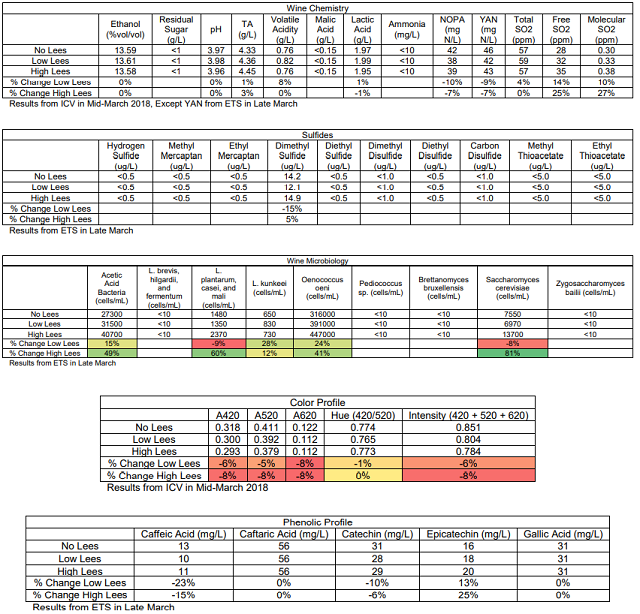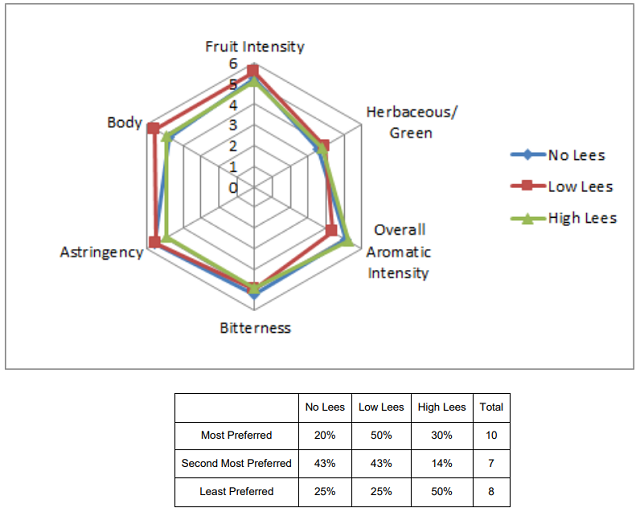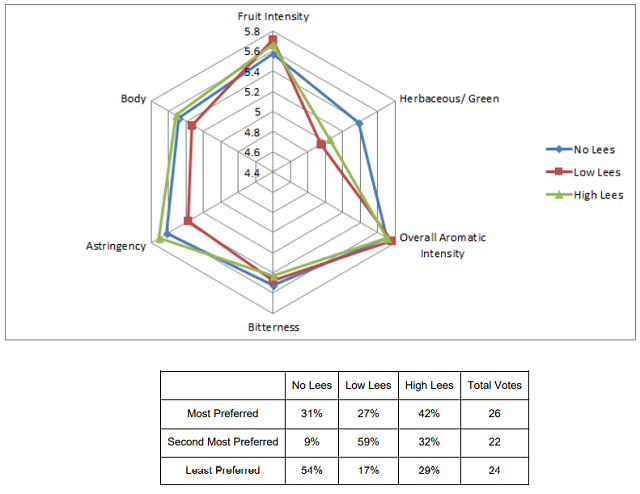The Impact of Adding Chardonnay Lees to Aging Red Wine (2017)
Theo Smith
Rappahannock Cellars
Summary
This study examines the impact of adding chardonnay lees to aging Cabernet Franc wine on mouthfeel and aroma. Cabernet Franc wine was cleanly racked into 3 separate, identical barrels on December 29, 2017 so that very little lees were transferred. Then: 1) one barrel received no addition of Chardonnay lees, 2) one received 1 liter of Chardonnay lees, approximately 1.02x106 cells/mL (Low NTU), and 3) one received 3 liters of Chardonnay lees, approximately 3.06x106 cells/mL. Lees were light lees, harvested from Chardonnay wines fermented with D254. The yeast in the lees were budding under microscope, and so 90ppm of sulfur dioxide was added to the lees before adding to barrel. The wines were stirred once every two weeks until taken for sampling in late March, 2018. No major wine chemistry differences were apparent between treatments. Sulfides were all similar between wines, with some differences in Dimethyl Sulfide. Microbial cell counts were generally higher in wine with lees additions. Color intensity was slightly lower in wine with lees added. Phenolic profiles were very similar, with perhaps a slight decrease in tannin with lees addition. Overall, low lees addition had a slight tendency to increase Fruit Intensity. Lees addition in general seemed to slightly lower Astringency. However, many of these differences were weak, and differed between tastings. The lees addition wines were generally more preferred over the control wine. This suggests that lees addition to red wines can be of benefit to red wine quality. More research with more rigorous sensory analysis is needed to further clarify what aspects of wine sensory characteristics are impacted by lees addition.
Introduction
Marchal et al. (2011) provide an excellent brief review of yeast autolysis in their introduction. Lees are mainly composed of yeast, bacteria, tartaric acid, polysaccharides, and protein-tannin complexes (Zoecklein 2013). Heavy lees generally refers to lees which precipitate 24 hours after fermentation (generally grape particles and large complexes of other lees particulates), and can often lead to offaromas in wine. Light lees precipitate later and are generally beneficial to wine quality, and have less grape particulates and less heavily complexed yeasts and other lees particulates (Zoecklein 2005; Zoecklein 2013). Lees aging can decrease vanilla flavors from oak, and increase toasted flavors (Chatonnet et al. 1992; Tominaga et al. 2000). Others have observed that lees stirring increases yeast character in the wine, decreases fruit and oak character. In some cases, this reduction in oak character can increase the perception of fruit (relative to very oaky control wines) (Zoecklein 2005).
Lees aging also increases the polysaccharide content of wines, particularly mannoproteins, which may enhance wine protein and tartrate stability (Llaubères et al. 1987; Ledoux et al. 1992; Moine-Ledoux et al. 1997; Feuillat 2003; Zoecklein 2005; Zoecklein 2013). Sur lies aging releases mannoproteins and other cell wall polysaccharides which can enhance the colloidal structure, stability, and aromatic quality of red wines while reducing their astringency, making sur lie aging of red wines important (Zoecklein 2005). Although yeast-derived proteins can increase during lees aging, these proteins are not involved in protein instability (Zoecklein 1991).
Lees may also act to preserve fruity and varietal characteristics by preventing oxidation and producing a reducing environment (Marchal et al. 2011; Zoecklein 2013). The release of thiols into the wine from yeast has been attributed to lowering reductive characteristics by being able to oxidize methanethiol and ethanethiol into their nonvolatile disulfide forms (Lavigne and Dubourdieu 1996); however, this greatly depends on other factors in the aging process, and could impart a more reductive character to the wine. Yeast glycoproteins from autolysis may also decrease astringency in wines through interaction with phenolic compounds (Escot et al. 2001). Lees autolysis can also impart sweetness to wine (Zoecklein 2005; Marchal et al. 2001), which may be in part due to sweet peptide fractions released during cell autolysis. One such fraction appears to be derived from heat shock proteins (Hsp12p) (Marchal et al. 2011), which is expressed from high temperature, ethanol, oxidative stress, and glycerol concentrations (Varela et al. 1995). All of these factors are present under winemaking conditions (Marchal et al. 2011). The breakdown of peptides can result in aromatic precursors in wines (Zoecklein 2005), but may also provide more nitrogen for spoilage organisms to consume. Many of these impacts of lees aging can be affected by winemaking practices, such as frequency of stirring, amount of lees present, amount of oxygen ingress, pectinase/glucosidase enzyme additions (such as Extralyse by Laffort), and perhaps even quality of lees.
Results and Discussion
No major wine chemistry differences were apparent between treatments. Sulfides were all similar between wines, with some differences in Dimethyl Sulfide. Microbial cell counts were generally higher in wine with lees additions. Color intensity was slightly lower in wine with lees added. Phenolic profiles were very similar, with perhaps a slight decrease in tannin with lees addition.


On the April 18 tasting, there were no strong trends for the descriptors used in this study. There was a slight tendency for the low lees treatment to have the highest Body, Fruit Intensity, and the lowest Overall Aromatic Intensity. The high lees treatment had a slight tendency for the lowest rating of Astringency. There was a slight preference for the wine with Low Lees, and the least preferred was generally the wine with High Lees.

For the descriptive analysis on May 30, there were no strong trends for the descriptors used in this study. Lees addition tended to lower Herbaceous/Green Character and increase Fruit Intensity. Interestingly, the low lees addition seemed to have stronger impacts on sensory characteristics than the high lees addition. The low lees treatment tended to have lower Astringency and Body. It should be noted, however, that these values are actually fairly close, and range on a scale from 4.0-6.0. These trends, therefore, are more minor than they may appear. In general, wines with lees additions tended to be most preferred, although this preference was relatively split between the lees treatments.

Overall, low lees addition had a slight tendency to increase Fruit Intensity. Lees addition in general seemed to slightly lower Astringency. However, many of these differences were weak, and differed between tastings. The lees addition wines were generally more preferred over the control wine. This suggests that lees addition to red wines can be of benefit to red wine quality. More research with more rigorous sensory analysis is needed to further clarify what aspects of wine sensory characteristics are impacted by lees addition.
Methods
Indian Springs 97 Cab Franc was harvested on September 28, 2017 and processed into multiple tanks and macrobins. The must was inoculated with 25g/hL CVRP and 30g/hL Go Ferm. On September 30, each tank received 30g/hL Go Ferm and 0.5g/hL lactic acid bacteria. On October 19 all tanks were drained and pressed into multiple tanks and received 8g/hL No Brett Inside. These were all combined on November 13 into one tank, and 60ppm sulfur dioxide was added. Wine was split into barrels on December 29, and wine was very settled so not much of the wine’s own lees came with it. The wine was racked to 5 year old Madoux Barrels, Minnesota oak. The following treatments were performed:
- Barrel 1: Control
- Barrel 2: Chardonnay Lees Low NTU (1 liter of lees, approximately 1.02E6 cells/mL counted microscopically)
- Barrel 3: Chardonnay Lees High NTU (3 liters of lees, approximately 3.06E6 cells/mL)
Lees from barrel-fermented Chardonnay were harvested from wines produced earlier in the season, fermented with D254, allowed to settle, and the lighter lees (on top) were then used as the exogenous lees source so long as they did not taste sour or unusual. The yeast from the lees were budding under microscope, and as such the lees were sulfured with 90ppm sulfur dioxide before being added to barrel. The wines were stirred once every two weeks until taken for sampling.
These wines were tasted on April 18 and May 30. In order to balance the data set to perform statistical analysis for descriptive analysis on the April 18 tasting, any judge who had not fully completed the descriptive analysis ratings were removed. In order to then make the number of judges between groups equivalent, one judge from group 1 was transferred to group 3, and another judge from group 1 and 2 were eliminated. This resulted in a final data set of 3 groups, each with 3 judges (considered as replications within groups, and groups were considered as assessors). Data was analyzed using Panel Check V1.4.2. Because this is not a truly statistical set-up, any results which are found to be statistically significant (p<0.05) will be denoted as a “strong trend” or a “strong tendency,” as opposed to general trends or tendencies. The statistical significance here will ignore any other significant effects or interactions which may confound the results (such as a statistically significant interaction of Judge x Wine confounding a significant result from Wine alone). The descriptors used in this study were Fruit Intensity, Herbaceous/Green, Overall Aromatic Intensity, Bitterness, Astringency, and Body.
The same procedures for data analysis were used on the May 30 tasting. For the descriptive analysis in this tasting, 1 judge was transferred from group 3 to group 1, and then again 1 judge from group 3 to group 2, and then 2 extra judges from group 3 were eliminated so that each group had 7 judges, for a total of 21 judges.
References
Chatonnet, P., Dubourdieu, D., and Boidron, J. N. 1992. Incidence des conditions de fermentation et d’èlevage des vins blancs secs en barriques sur leur composition en substances cèdèes par le bois de chêne. Sci. Aliments. 12:665–685.
Escot, S., Feuillat, M., Dulau, L., and Charpentier, C. 2001. Release of polysaccharides by yeasts and the influence of released polysaccharides on colour stability and wine astringency. Aust. J. Grape Wine Res. 7:153–159.
Feuillat, M. 2003. Yeast macromolecules: Origin, composition, and enological interest. Am. J. Enol. Vitic. 54:211- 213. Lavigne, V. and Dubourdieu, D. 1996. Demonstration and interpretation of the yeast lees ability to adsorb certain volatile thiols contained in wine. J. Int. Sci. Vigne Vin. 30:201–206.
Ledoux, V., Dulau, L., and Dubourdieu, D. 1992. Interprètation de l’amèlioration de la stabilitè protèique des vins au cours de l’èlevage sur lies. J. Int. Sci. Vigne Vin. 26:239–251
Llaubères, R.-M., Dubourdieu, D., and Villettaz, J.-C. 1987. Exocellular polysaccharides from Saccharomyces in Wine. J. Sci. Food Agric. 41:277–286.
Marchal, A., Marullo, P., Moine, V., and Dubourdieu, D. 2011. Influence of yeast macromolecules on sweetness in dry wines: role of the Saccharomyces cerevisiae protein Hsp12. Journal of Agricultural and Food Chemistry. 59:2004-2010.
Moine-Ledoux, V., Perrin, A., Paladin, I., and Dubourdieu, D. 1997. Premiers rèsultats de stabilisation tartrique des vins par addition de mannoprotèines purifièes (Mannostab). J. Int. Sci. Vigne Vin. 31:23–31.
Tominaga, T., Blanchard, L., Darriet, P., and Dubourdieu, D. 2000. A powerful aromatic volatile thiol, 2- furanmethanethiol, exhibiting roast coffee aroma in wines made from several Vitis vinifera grape varieties. J. Agric. Food Chem. 48:1799–1802.
Varela, J. C. S., Praekelt, U. M., Meacock, P. A., Planta, R. J., and Mager, W. H. 1995. The Saccharomyces cerevisiae HSP12 gene is activated by the high- osmolarity glycerol pathway and negatively regulated by protein kinase A. Mol. Cell. Biol. 15:6232–6245.
Zoecklein, B. 1991. Protein stability determination in juice and wine. Virginia Cooperative Extension. http://www.apps.fst.vt.edu/extension/enology/downloads/ProteinS.pdf.
Zoecklein, B. 2013. Nature of wine lees. Practical Winery and Vineyard. July. http://www.apps.fst.vt.edu/extension/enology/downloads/wm_issues/Nature%20of%20Wine%20 Lees.pdf
Zoecklin, B. 2005. Lees Management. Enology Notes #106. http://www.apps.fst.vt.edu/extension/enology/EN/106.html.
